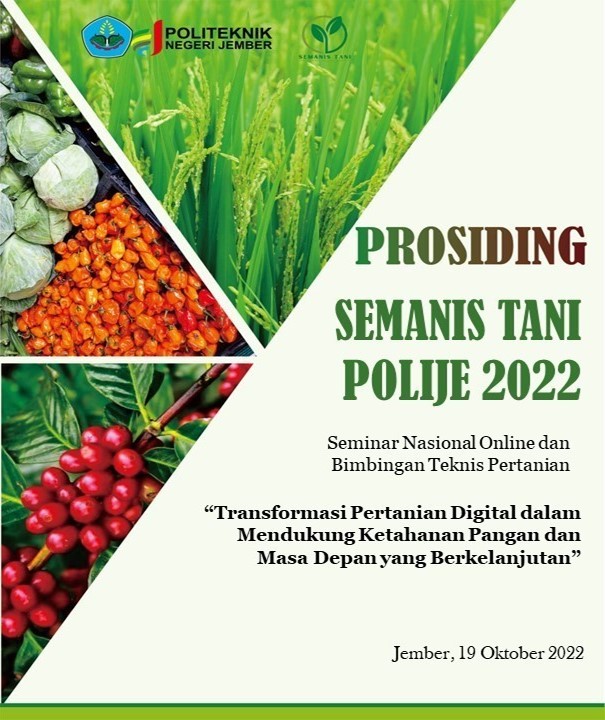ANALISIS KELAYAKAN FINANSIAL PERBENIHAN LADA DALAM PENYEDIAAN BENIH BERMUTU DAN BERSERTIFIKAT DI TAMAN SAINS PERTANIAN
DOI:
https://doi.org/10.25047/agropross.2022.316Kata Kunci:
Cost structure, Financial feasible, PepperAbstrak
This study aims to determine the financial feasibility of one segment pepper seed cutting business. The research was carried out at the Natar Agricultural Science Park (TSP) of South Lampung Regency, the Center for the Assessment of Agricultural Technology in 2021. The planting material used was one segment pepper cuttings obtained from Balittro. Planting is carried out from March to September 2021. The qualitative approach consists of a cost structure, income analysis, B/C ratio, R/C ratio, and Break Even Point (BEP). Analysis of the cost structure of pepper seed farming consists of total fixed costs (TFC), total variable costs (TVC) and total costs (TC). Total costs consist of fixed costs of Rp. 11,537,500, - and variable costs of Rp. 58,708,500,-. Variable costs in the cost structure contributed the largest 83.58 percent compared to fixed costs of 16.42 percent. The income earned is Rp. 81,654,000,-. Pepper seed farming reached the break-even point (BEP) in seed production of 2,324 plants. The R/C ratio and B/C ratio of pepper seed were 2.16 and 1.16, respectively. This value is greater than 1, so it can be concluded that pepper seed farming is feasible.
Unduhan
Referensi
Asmara, R., & Nurholifah, R. (2010). Analisis pendapatan dan faktor-faktor yang mempengaruhi pendapatan petani tebu dalam keanggotaan suatu koperasi. Agrise, 5(2), 108–120.
BPTP Lampung. (2012). Budidaya Tanaman Lada.
Fachrista, Irma Audiah, S. dan D. R. (2014). Analisis Kelayakan Ekonomi Perbanyakan Benih Lada Setek Satu Ruas. Pengembangan Teknologi Pertanian Politeknik Negeri Lampung.
Ginting, KH. (2014). Analisis Posisi Lada Putih Indonesia di Pasar Lada Putih Dunia. IPB University.
Karmawati, E., & H. Supriyadi. (2007). Keragaan usahatani lada di Lampung. Prosiding Seminar Rempah, 196–202.
Mahdi, N., & Suprehatin, S. (2021). Posisi Pasar Lada Indonesia di Pasar Global. Jurnal Ekonomi Pertanian Dan Agribisnis, 5(2), 595–605. https://doi.org/10.21776/ub.jepa.2021.005.02.26
Marthalia, E. (2018). Analisis Struktur Biaya, Pendapatan, Dan Risiko Usahatani Terung Ungu (Solanum Melongena L.) Di Desa Simpang Kanan Kecamatan Sumberejo Kabupaten Tanggamus.
Maruta, H. (2018). Laba, Perencanaan Manajemen, Bagi. Jurnal Akuntasi Syariah, 2(1), 9–28.
Muis, R. (2007). Kebijakan pengembangan rempah Indonesia. Prosiding Seminar Nasional Rempah, 1–7.
Nurhakim, Y. I. (2014). Perkebunan lada cepat panen. Infra Pustaka.
Soekartawi. (2002). Analisis Usahatani. UI Press.
Syakir, M., & A. Dhalimi. (1996). Monograf tanaman lada. Balai Penelitian Tanaman Rempah dan Obat.
Unduhan
Diterbitkan
Cara Mengutip
Terbitan
Bagian
Lisensi
Hak Cipta (c) 2022 Zahara, Dewi Rumbaina Mustika, Nila Wardani, Jekyy Hendra, Herna Suhartin

Artikel ini berlisensi Creative Commons Attribution 4.0 International License.
Hak cipta (Copyright) artikel yang dipublikasikan di Agropross : National Conference Proceedings of Agriculture dipegang oleh penulis (Copyright by Authors) di bawah Creative Commons Attribution 4.0 International License (CC-BY). Sehingga penulis tidak memerlukan perjanjian pengalihan hak cipta yang harus diserahkan kepada redaksi.






